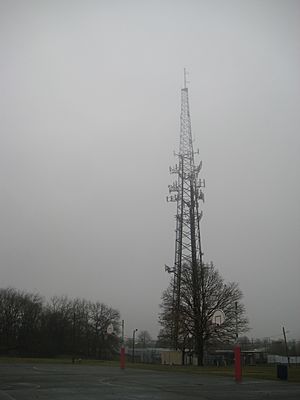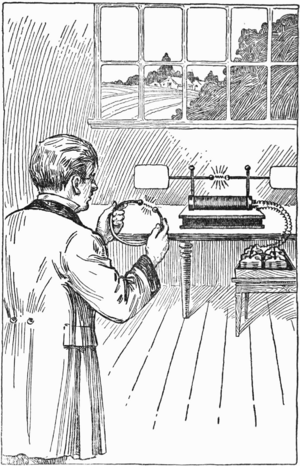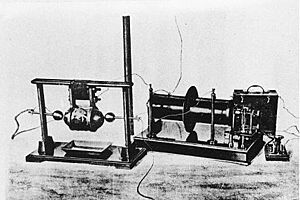Transmitter facts for kids
In electronics, a transmitter is a special device. It sends out signals using invisible waves called radio waves. Think of it like a speaker for radio waves. It takes information, like music or voices, and turns it into radio waves. These waves then travel through the air to a receiver, which catches them.
Transmitters are super important for many things. They help us listen to the radio and watch TV. They also make cell phones work and allow Wi-Fi to connect devices. Even things like GPS and remote controls use transmitters.
Contents
How Transmitters Work
A transmitter changes direct current (DC) electricity into alternating current (AC). This AC electricity vibrates at a specific speed, called a frequency. Most transmitters use a tiny piece of quartz crystal. This crystal helps keep the frequency very steady and accurate.
Adding Information to the Waves
The main radio wave that a transmitter creates is called a "carrier wave." This wave doesn't carry any information by itself. To add information, like sound or video, a part called a "modulator" is used.
The modulator changes the carrier wave in a special way. There are a few ways to do this:
- Frequency Modulation (FM): This changes how fast the waves vibrate. It's like changing the pitch of a sound. FM is used for clear radio broadcasts.
- Amplitude Modulation (AM): This changes how strong the waves are. It's like changing the volume of a sound. AM is used for longer-distance radio broadcasts.
Once the information is added, the modified waves are sent out. They travel from an antenna on the transmitter. Another antenna on a receiver then picks up these waves. The receiver then takes the information out of the waves.
Types of Transmitters
Transmitters come in many shapes and sizes. They are designed for different jobs.
Radio and TV Transmitters
These are big and powerful transmitters. They send out signals for radio and television stations. They need tall towers and strong antennas to reach many homes.
Communication Transmitters
Smaller transmitters are found in your cell phone. They send your voice and data to cell towers. Wi-Fi routers also have transmitters. They send internet signals to your computer or tablet.
Special Purpose Transmitters
Some transmitters are used for very specific tasks.
- Radar: These transmitters send out radio waves to detect objects. They are used in airplanes and ships to see things far away.
- Remote Controls: Your TV remote has a tiny transmitter. It sends out infrared light signals to change channels.
History of Transmitters
The idea of sending signals through the air started a long time ago.
Early Discoveries
In 1887, a scientist named Heinrich Hertz proved that radio waves exist. He built a simple device that could create and detect these waves. This was the very first basic transmitter.
Spark Gap Transmitters
Around 1895, Guglielmo Marconi developed the first practical radio systems. He used "spark gap transmitters." These devices created radio waves by making electric sparks. They were noisy but allowed the first wireless messages to be sent over long distances.
Continuous Wave Transmitters
Spark gap transmitters sent out short bursts of waves. Scientists wanted to send out a continuous, steady wave. This would allow for clearer sound and more information.
- The Poulsen arc transmitter (from 1903) used an electric arc to make continuous waves.
- The Alexanderson alternator (from 1910) was a huge machine that also made continuous waves.
The Rise of Vacuum Tubes
A big step forward came with the invention of the vacuum tube. These tubes could create and control radio waves much better.
In the 1920s, vacuum tubes made modern radio broadcasting possible. They allowed for clearer sound and more reliable signals. This led to the growth of radio stations around the world.
Modern Transmitters
Today, transmitters use advanced electronic parts like transistors and integrated circuits. These make them smaller, more powerful, and more efficient. From your tiny cell phone to giant broadcast towers, transmitters are everywhere. They help us stay connected and informed every day.
Images for kids
-
Animation of a half-wave dipole antenna transmitting radio waves, showing the electric field lines. The antenna in the center is two vertical metal rods, with an alternating current applied at its center from a radio transmitter (not shown). The voltage charges the two sides of the antenna alternately positive (+) and negative (−). Loops of electric field (black lines) leave the antenna and travel away at the speed of light; these are the radio waves. This animation shows the action slowed enormously.
See also
 In Spanish: Radiotransmisor para niños
In Spanish: Radiotransmisor para niños













